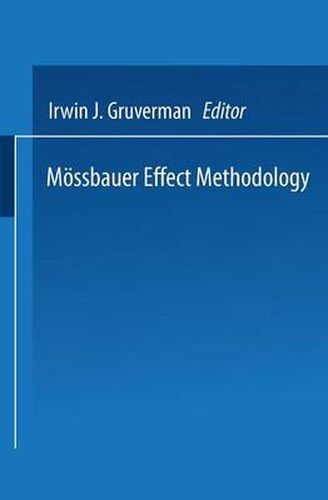Readings Newsletter
Become a Readings Member to make your shopping experience even easier.
Sign in or sign up for free!
You’re not far away from qualifying for FREE standard shipping within Australia
You’ve qualified for FREE standard shipping within Australia
The cart is loading…






This title is printed to order. This book may have been self-published. If so, we cannot guarantee the quality of the content. In the main most books will have gone through the editing process however some may not. We therefore suggest that you be aware of this before ordering this book. If in doubt check either the author or publisher’s details as we are unable to accept any returns unless they are faulty. Please contact us if you have any questions.
Mossbauer Effect Methodology, Volume 1, records the proceedings of the First Symposium on Mossbauer Effect Methodology. This Symposium was sponsored by the New England Nuclear Corporation and the Technical Measurement Corporation, and was devoted to principles, techniques, and applications of the Mossbauer effect. The Symposium was held at the Sheraton-Atlantic Hotel in New York City on january 26, 1965. Dr. Stanley Ruby, of Argonne National Laboratory, was Chairman of the aU-day session. About 250 people attended the Symposium, and interest appeared sufficient to warrant continuation of this Symposium series. It is hoped that future Symposia can be organized which will serve as a forum for presentation of advances in methodology. The papers presented in this volume review the current status of applications, describe instrument systems used, elu cidate measurement techniques applied, and formulate means of creating required environments for use in Mossbauer effect studies. With the proliferation of applications of the Mos sbauer effect in physics, as well as in chemistry and biology, the need for complete description of transducer systems, detection and data handling methods, and environment modification techniques be came apparent. The body of such experience, developed and possessed by a relatively small group of physicists, primarily, has not been readily accessible to those in other fields. The editor organized this Symposium in response to many expres sions of a need for such information.
$9.00 standard shipping within Australia
FREE standard shipping within Australia for orders over $100.00
Express & International shipping calculated at checkout
This title is printed to order. This book may have been self-published. If so, we cannot guarantee the quality of the content. In the main most books will have gone through the editing process however some may not. We therefore suggest that you be aware of this before ordering this book. If in doubt check either the author or publisher’s details as we are unable to accept any returns unless they are faulty. Please contact us if you have any questions.
Mossbauer Effect Methodology, Volume 1, records the proceedings of the First Symposium on Mossbauer Effect Methodology. This Symposium was sponsored by the New England Nuclear Corporation and the Technical Measurement Corporation, and was devoted to principles, techniques, and applications of the Mossbauer effect. The Symposium was held at the Sheraton-Atlantic Hotel in New York City on january 26, 1965. Dr. Stanley Ruby, of Argonne National Laboratory, was Chairman of the aU-day session. About 250 people attended the Symposium, and interest appeared sufficient to warrant continuation of this Symposium series. It is hoped that future Symposia can be organized which will serve as a forum for presentation of advances in methodology. The papers presented in this volume review the current status of applications, describe instrument systems used, elu cidate measurement techniques applied, and formulate means of creating required environments for use in Mossbauer effect studies. With the proliferation of applications of the Mos sbauer effect in physics, as well as in chemistry and biology, the need for complete description of transducer systems, detection and data handling methods, and environment modification techniques be came apparent. The body of such experience, developed and possessed by a relatively small group of physicists, primarily, has not been readily accessible to those in other fields. The editor organized this Symposium in response to many expres sions of a need for such information.